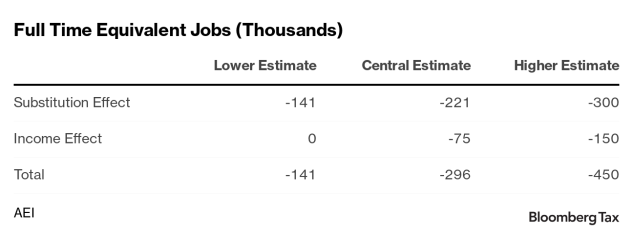Unintended Consequences: Democrat's Child Tax Credit Will Cost Jobs
This post first appeared on April 22, 2021 at Bloomberg Tax. Bloomberg Tax Insights articles are written by experienced practitioners, academics, and policy experts discussing developments and current issues in taxation.
By Alex Brill, Kyle Pomerleau, and Grant M. Seiter
President Biden’s first signature legislative accomplishment, the American Rescue Plan Act (ARPA), is now law. Nearly $1.2 trillion in fiscal aid will pour into the economy before October, and another $700 billion will be doled out over the next four years. As one of us has written previously, $1.9 trillion is a significant underestimate of the plan’s total cost if temporary expansions of several tax credits are permanently extended. The largest of these temporary policies is the expanded child tax credit (CTC), touted by Democrats as a boon to low- and middle-income households. In addition to being costlier than the sticker price, a permanent CTC expansion, a goal expressed by many Democratic lawmakers, would have the unintended consequence of reducing employment.
Under the American Rescue Plan, the CTC was temporarily increased (for 2021) to $3,600 for each child under age six and $3,000 for each child age six to seventeen. The credit was also made fully refundable, which means that the full credit is available to taxpayers even if its value exceeds their income tax liability. The additional credit will phase-out for households by 5 cents per dollar of income over $75,000 ($150,000 for married couples filing jointly). For example, a household with two young children and little or no wage income will now get a $7,200 CTC. Previously, only $1,400 of the credit was refundable, thereby capping the maximum refundable benefit for the same family at $2,800.
The large increase in the value of the CTC and the expansion of the population eligible for the full credit amount will boost disposable income for low- and middle-income households, increase the progressivity of the tax system, and reduce poverty rates. By our calculations, the CTC expansion will reduce the childhood Supplemental Poverty Rate from 12.4% to 8%. That means 3 million fewer children in poverty.
However, policy analysts have expressed concerns that there may be unintended consequences of such a large expansion. One concern is that the expanded CTC will reduce work incentives and thereby lower employment. The previous CTC encouraged work among low-income households because it increased in value as wages increased, much like the earned income tax credit. Under prior law, the CTC lowered marginal tax rates on wage income for low-income households with children by about eight percentage points. With the credit fully refundable, this work incentive is gone.
We analyzed the impact of a permanent CTC expansion on employment using AEI’s Tax-Calculator along with an employment model and set of assumptions from the Congressional Budget Office (CBO). According to our calculation, the likely impact of the CTC expansion on employment will be 296,000 full-time equivalent jobs lost (+/- 155,000). (A technical description of our methodology is available here. This is due to both the elimination of the phase-in and the phase-out of the larger benefit.

President Biden’s agenda for reducing poverty is not limited to the CTC expansion, and neither are the unintended consequences. A companion objective of the President and many Democratic lawmakers is an increase in the minimum wage to $15 per hour. While permanently expanding the CTC enjoys broad support among Democrats and many Republicans, a hike in the federal minimum wage has met more political opposition. One possible reason is that the adverse impact of a minimum wage is more intuitive, more widely discussed, and significantly larger.
In a February report on the economic and budgetary effects of phasing in an increase in the federal minimum wage to $15 per hour, CBO estimated that such a change would lift 900,000 households out of poverty but reduce overall employment by 1.4 million, an employment effect nearly five times larger than the impact of the CTC expansion. While the employment loss associated with a permanent CTC expansion may be modest relative to a $15 per hour minimum wage, it should not be ignored.
President Biden’s overarching goal of reducing poverty, child poverty in particular, is commendable, and many parts are good policy. For example, the expansion of the earned income tax credit and the child and dependent care tax credit in the ARPA are both laudable steps toward that goal that also encourage work. As lawmakers consider making the CTC expansion permanent, debate a minimum wage hike, or develop other policy reforms to address the needs of low-income households, unintended consequences must be carefully considered.
Alex Brill and Kyle Pomerleau are resident fellows and Grant M. Seiter is a research assistant at the American Enterprise Institute.